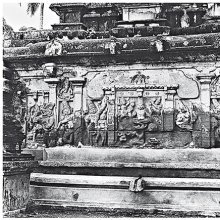Amareshvara, Amareśvara, Amara-ishvara: 13 definitions
Introduction:
Amareshvara means something in Hinduism, Sanskrit, the history of ancient India. If you want to know the exact meaning, history, etymology or English translation of this term then check out the descriptions on this page. Add your comment or reference to a book if you want to contribute to this summary article.
The Sanskrit term Amareśvara can be transliterated into English as Amaresvara or Amareshvara, using the IAST transliteration scheme (?).
Images (photo gallery)
In Hinduism
Purana and Itihasa (epic history)
Source: archive.org: Shiva Purana - English Translation1) Amareśvara (अमरेश्वर) refers to one of twelve Jyotirliṅgas, according to the Śivapurāṇa 1.22 while explaining the importance of the partaking of the Naivedya of Śiva. Amareśvara is located at Ujjain.
2) Amareśvara (अमरेश्वर) refers to the “lord of Devas”, and is used as an epithet for Śiva, as mentioned in the Mahāmṛtyuñjaya-mantra, according to the Śivapurāṇa 2.2.38.—Accordingly, as Śukra related the Mahāmṛtyuñjaya to Dadhīca:—“We worship the three-eyed lord Śiva, the lord of the three worlds, the father of the three spheres, the lord of the three guṇas. Lord Śiva is the essence, the fragrance of the three tattvas, three fires, of every thing that is trichotomised, of the three worlds, of the three arms and of the trinity. He is the nourisher. In all living beings, everywhere, in the three guṇas, in the creation, in the sense-organs, in the Devas and Gaṇas, he is the essence as the fragrance in a flower. He is the lord of Devas (amareśvara). [...]”.

The Purana (पुराण, purāṇas) refers to Sanskrit literature preserving ancient India’s vast cultural history, including historical legends, religious ceremonies, various arts and sciences. The eighteen mahapuranas total over 400,000 shlokas (metrical couplets) and date to at least several centuries BCE.
Shaktism (Shakta philosophy)
Source: Google Books: ManthanabhairavatantramAmareśvara (अमरेश्वर) refers to one of the eight Bhairavas (bhairava-aṣṭaka) associated with Candrapīṭha (or Candrapīṭhapura), according to the Manthānabhairavatantra, a vast sprawling work that belongs to a corpus of Tantric texts concerned with the worship of the goddess Kubjikā.—[...] The eight Bhairavas (bhairavāṣṭaka): Ciñciṇīnātha, Someśvara, Amṛta, Śaṃkara, Trimūrti, Amareśvara, Bhārabhūti, Atithi.—(Note the variant Parameśvara).

Shakta (शाक्त, śākta) or Shaktism (śāktism) represents a tradition of Hinduism where the Goddess (Devi) is revered and worshipped. Shakta literature includes a range of scriptures, including various Agamas and Tantras, although its roots may be traced back to the Vedas.
Shaivism (Shaiva philosophy)
Source: Brill: Śaivism and the Tantric TraditionsAmareśvara (अमरेश्वर) is the name of a temple at Oṃkāreśvar/Māndhātā.—The text of the Halāyudhastotra is recorded, together with the Mahimnastava and a Narmadāstotra, on an inscription of 1063AD (saṃvat 1120) in the Amareśvara temple at Oṃkāreśvar/Māndhātā.—For an overview of the inscriptions of the Amareśvara temple and the publication of several more hitherto unpublished inscriptions from the temple, including the Narmadāstotra, see Neuss 2013 and 2015.

Shaiva (शैव, śaiva) or Shaivism (śaivism) represents a tradition of Hinduism worshiping Shiva as the supreme being. Closely related to Shaktism, Shaiva literature includes a range of scriptures, including Tantras, while the root of this tradition may be traced back to the ancient Vedas.
India history and geography
Source: archive.org: Nilamata Purana: a cultural and literary study (history)Amareśvara (अमरेश्वर) is the name of a tīrtha (sacred place) as mentioned in the Nīlamatapurāṇa.—Amareśvara is the tīrtha on the snowy peaks of Amaranātha.

The history of India traces the identification of countries, villages, towns and other regions of India, as well as mythology, zoology, royal dynasties, rulers, tribes, local festivities and traditions and regional languages. Ancient India enjoyed religious freedom and encourages the path of Dharma, a concept common to Buddhism, Hinduism, and Jainism.
Languages of India and abroad
Sanskrit dictionary
Source: DDSA: The practical Sanskrit-English dictionaryAmareśvara (अमरेश्वर).—&c. 'The lord of the gods', epithets of Indra; प्रेमदत्तवदना- निलः पिवन्नत्यजीवदमरालकेश्वरौ (premadattavadanā- nilaḥ pivannatyajīvadamarālakeśvarau) R.19.15. शान्तं पापं न वः किंचित् कुतश्चिदमराधिप (śāntaṃ pāpaṃ na vaḥ kiṃcit kutaścidamarādhipa) Rām.2.74.22. sometimes of Śiva and Viṣṇu also,
Derivable forms: amareśvaraḥ (अमरेश्वरः).
Amareśvara is a Sanskrit compound consisting of the terms amara and īśvara (ईश्वर). See also (synonyms): amarādhipa, amarendra, amareśa, amarapati, amarabhartā, amararāja.
Source: Cologne Digital Sanskrit Dictionaries: Shabda-Sagara Sanskrit-English DictionaryAmareśvara (अमरेश्वर).—m.
(-raḥ) Indra. E. amara, and īśvara chief.
Source: Cologne Digital Sanskrit Dictionaries: Benfey Sanskrit-English DictionaryAmareśvara (अमरेश्वर).—m. a name of Viṣṇu, [Rāmāyaṇa] 1, 77, 29; of Indra, [Raghuvaṃśa, (ed. Stenzler.)] 19, 15.
Amareśvara is a Sanskrit compound consisting of the terms amara and īśvara (ईश्वर).
Source: Cologne Digital Sanskrit Dictionaries: Cappeller Sanskrit-English DictionaryAmareśvara (अमरेश्वर).—[masculine] lord of the gods, [Epithet] of Śiva, Viṣṇu, or Indra.
Source: Cologne Digital Sanskrit Dictionaries: Aufrecht Catalogus CatalogorumAmareśvara (अमरेश्वर) as mentioned in Aufrecht’s Catalogus Catalogorum:—Śivārcanapaddhati. K. 52.
Source: Cologne Digital Sanskrit Dictionaries: Monier-Williams Sanskrit-English Dictionary1) Amareśvara (अमरेश्वर):—[from a-mara > a-mamri] m. = amara-pa q.v., [Śākaṭāyana; Raghuvaṃśa xix, 15]
2) [v.s. ...] Name of Viṣṇu, [Rāmāyaṇa i, 77, 29]
3) [v.s. ...] Name of a Liṅga.
Source: Cologne Digital Sanskrit Dictionaries: Yates Sanskrit-English DictionaryAmareśvara (अमरेश्वर):—[a-mare+śvara] < [a-mareśvara] (raḥ) 1. m. Idem.
[Sanskrit to German]
Sanskrit, also spelled संस्कृतम् (saṃskṛtam), is an ancient language of India commonly seen as the grandmother of the Indo-European language family (even English!). Closely allied with Prakrit and Pali, Sanskrit is more exhaustive in both grammar and terms and has the most extensive collection of literature in the world, greatly surpassing its sister-languages Greek and Latin.
See also (Relevant definitions)
Partial matches: Ishvara, Amara, A.
Starts with: Amareshvara shastrin, Amareshvarakalpa, Amareshvaramahatmya, Amareshvaratirtha.
Ends with: Shadjamareshvara.
Full-text (+12): Amareshvara shastrin, Candabhaskara, Ajnanadhvantacandabhaskara, Amareshvaratirtha, Shivarcanapaddhati, Vallabhendra, Halayudha, Shankara, Atithi, Vivekarashi, Someshvara, Gandhadhvaja, Bharabhuti, Amarabharta, Amaresha, Vijnanabhairava, Amaradhipa, Amarapati, Amarendra, Halayudhastotra.
Relevant text
Search found 13 books and stories containing Amareshvara, Amareśvara, Amara-ishvara, Amara-īśvara, Amaresvara, Amara-isvara, A-mareshvara, A-mareśvara, A-maresvara; (plurals include: Amareshvaras, Amareśvaras, ishvaras, īśvaras, Amaresvaras, isvaras, mareshvaras, mareśvaras, maresvaras). You can also click to the full overview containing English textual excerpts. Below are direct links for the most relevant articles:
The Skanda Purana (by G. V. Tagare)
Chapter 194 - Greatness of Amareśvara (Amara-īśvara) < [Section 1 - Prabhāsa-kṣetra-māhātmya]
Chapter 146 - Greatness of Amareśvara Kuṇḍa < [Section 1 - Tīrtha-māhātmya]
Chapter 21 - The Origin of the River Kapilā < [Section 3 - Revā-khaṇḍa]
The history of Andhra country (1000 AD - 1500 AD) (by Yashoda Devi)
Part 18 - The Kotas of Tadikonda < [Chapter V - The Kotas (A.D. 1100-1270)]
Rudra-Shiva concept (Study) (by Maumita Bhattacharjee)
14. Twelve Jyotirliṅga incarnations of lord Śiva < [Chapter 5 - Rudra-Śiva in the Purāṇic Literature]
Dvisahasri of Tembesvami (Summary and Study) (by Upadhyay Mihirkumar Sudhirbhai)
Chapter 11 - Narration of the Glory of the Confluence of Rivers Kṛṣṇā and Pañcanadī
Works of H. H. Ṭembesvāmī < [H. H. Ṭembesvāmī: Life, Date & Works]
Amaravati Art in the Context of Andhra Archaeology (by Sreyashi Ray chowdhuri)
Dhānyakaṭaka and other names of Amarāvatī < [Chapter 4 - Survival of Amarāvatī in the Context of Andhra Art]
The flourishing agriculture and prosperity in Amarāvatī (Dhānyakaṭaka) < [Chapter 4 - Survival of Amarāvatī in the Context of Andhra Art]
The Shiva Purana (by J. L. Shastri)
Chapter 22 - On the partaking of the Naivedya of Śiva and the greatness of Bilva < [Section 1 - Vidyeśvara-saṃhitā]
Chapter 42 - The Twelve Jyotirliṅga incarnations < [Section 3 - Śatarudra-saṃhitā]


